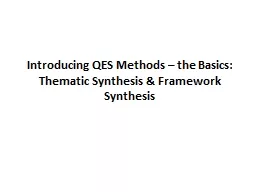

Basics Thematic Synthesis amp Framework Synthesis Framework for systematic reviews of qualitative research Garside 2010 Stage Typical activities Developing research question Assemble team Consult Agree approach ID: 563259
Download Presentation The PPT/PDF document "Introducing QES Methods – the" is the property of its rightful owner. Permission is granted to download and print the materials on this web site for personal, non-commercial use only, and to display it on your personal computer provided you do not modify the materials and that you retain all copyright notices contained in the materials. By downloading content from our website, you accept the terms of this agreement.
Slide1
Introducing QES Methods – the Basics: Thematic Synthesis & Framework Synthesis Slide2
Framework for systematic reviews of qualitative research (Garside, 2010)
Stage
Typical activitiesDeveloping research questionAssemble team; Consult; Agree approachScoping exerciseIdentify relevant research; Refine methodsIdentifying relevant literatureDevelop Inclusion/Exclusion criteria; Focused searches; Citation searchesInitial assessment of study reportsPreliminary reading; Identify theories; Assess utility/relevanceAnalysis and synthesisReading & rereading study reports; Constant comparison; Assess validityPreliminary synthesisCategorising; tabulating; mindmaps; Explore relationshipsFull synthesisThematic analysis; translation of findings; Theory development; rival explanationsDisseminationTarget audiences; Limitations of reviewThroughoutMultiple viewpoints; Reflexivity; Audit trail; Ongoing consultation; revisit review purposeSlide3
Two
QES Methods……..Slide4Slide5
Their Origins
Thematic Synthesis from
Thematic Analysis – assignment of themes to qualitative data (e.g. from interviews)Framework Synthesis from Framework Analysis – assignment of data from interviews etcetera to predefined domains of a frameworkSlide6
Thematic Synthesis
Either performed using:
Line as Unit of Analysis – Line-by-Line Coding – Eppi-Centre Method – Uses Qualitative SoftwareData Extract as Unit of Analysis – Assignment of Theme(s) – Uses Data Extraction themes for data extractsSlide7
Framework SynthesisSlide8
A FrameworkSlide9
How do you create a framework?
Develop own framework or themes or concepts for coding
Oliver S et al: A multidimensional conceptual framework for analysing public involvement in health services research. Health Expectations 2008, 11:72-84.Brunton G, Oliver S, Oliver K, Lorenc T. A Synthesis of Research Addressing Children’s, Young People’s and Parents’ Views of Walking and Cycling for Transport London. London, EPPI-Centre, Social Science Research Unit, Institute of Education, University of London; 2006.Identify or create a thematic framework or conceptual modelCarroll C, Booth A, Cooper K. A worked example of “best-fit” framework synthesis: A systematic review of views concerning the taking of potential chemopreventive agents, BMC Medical Research Methodology 2011; 11: 29Slide10
An existing conceptual framework
Conrad K, et al (1996). The worksite environment as a cue to smoking reduction.
Research in Nursing & Health, 19 21-31.Slide11Slide12
A FrameworkSlide13
Best Fit Framework SynthesisSlide14
Framework synthesis
Thematic synthesisSlide15
Why start with these methods?
Simplest methods of qualitative analysis
Many qualitative researchers already familiar with primary research counterpartsDo not preclude further analysis using more “advanced” methods e.g. thematic synthesis => meta-ethnographyConservative choice that accommodates most degrees of richness/thickness of qualitative dataSlide16
Challenges
Thematic Synthesis – Creating meaningful “labels” for the themes that emerge from the data. Establishing relationships between different themes
Framework synthesis – Not “squeezing” data into existing categories. Requires pre-definition of what categories mean (especially if taken from published framework).Slide17
Best Fit Framework Synthesis
Booth, A., & Carroll, C. (2015). Systematic searching for theory to inform systematic reviews: is it feasible? Is it desirable?.
Health Information & Libraries Journal. (Early View)Booth A and Carroll C (2015) How to build up the actionable knowledge base: the role of "best fit" framework synthesis for studies of improvement in healthcare. BMJ Quality & Safety (Forthcoming)Carroll, C., Booth, A., Leaviss, J., & Rick, J. (2013). “Best fit” framework synthesis: refining the method. BMC medical research methodology, 13(1), 37.Carroll, C., Booth, A., & Cooper, K. (2011). A worked example of "best fit" framework synthesis: A systematic review of views concerning the taking of some potential chemopreventive agents. BMC Medical Research Methodology,11(1), 1-9.Carroll, C., Rick, J., Leaviss, J., Fishwick, D., & Booth, A. (2013). A qualitative evidence synthesis of employees’ views of workplace smoking reduction or cessation interventions. BMC public health, 13(1), 1095.Dixon-Woods, M. (2011). Using framework-based synthesis for conducting reviews of qualitative studies. BMC medicine, 9(1), 39.